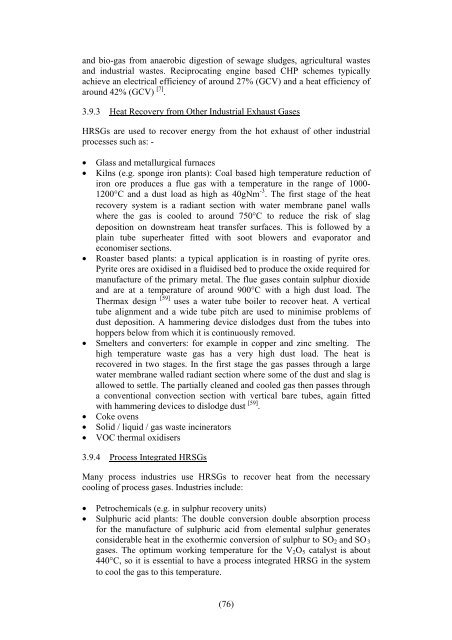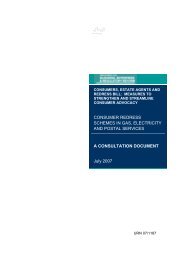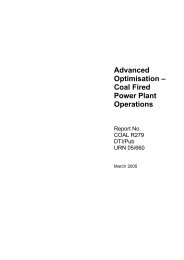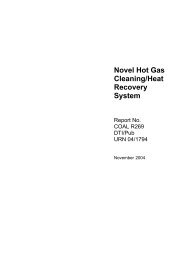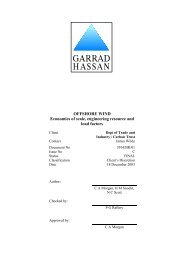(70) Therefore, the risk of sulphuric acid dew point attack ... - DTI Home
(70) Therefore, the risk of sulphuric acid dew point attack ... - DTI Home
(70) Therefore, the risk of sulphuric acid dew point attack ... - DTI Home
You also want an ePaper? Increase the reach of your titles
YUMPU automatically turns print PDFs into web optimized ePapers that Google loves.
and bio-gas from anaerobic digestion <strong>of</strong> sewage sludges, agricultural wastes<br />
and industrial wastes. Reciprocating engine based CHP schemes typically<br />
achieve an electrical efficiency <strong>of</strong> around 27% (GCV) and a heat efficiency <strong>of</strong><br />
around 42% (GCV) [7] .<br />
3.9.3 Heat Recovery from O<strong>the</strong>r Industrial Exhaust Gases<br />
HRSGs are used to recover energy from <strong>the</strong> hot exhaust <strong>of</strong> o<strong>the</strong>r industrial<br />
processes such as: -<br />
• Glass and metallurgical furnaces<br />
• Kilns (e.g. sponge iron plants): Coal based high temperature reduction <strong>of</strong><br />
iron ore produces a flue gas with a temperature in <strong>the</strong> range <strong>of</strong> 1000-<br />
1200°C and a dust load as high as 40gNm -3 . The first stage <strong>of</strong> <strong>the</strong> heat<br />
recovery system is a radiant section with water membrane panel walls<br />
where <strong>the</strong> gas is cooled to around 750°C to reduce <strong>the</strong> <strong>risk</strong> <strong>of</strong> slag<br />
deposition on downstream heat transfer surfaces. This is followed by a<br />
plain tube superheater fitted with soot blowers and evaporator and<br />
economiser sections.<br />
• Roaster based plants: a typical application is in roasting <strong>of</strong> pyrite ores.<br />
Pyrite ores are oxidised in a fluidised bed to produce <strong>the</strong> oxide required for<br />
manufacture <strong>of</strong> <strong>the</strong> primary metal. The flue gases contain sulphur dioxide<br />
and are at a temperature <strong>of</strong> around 900°C with a high dust load. The<br />
Thermax design [59] uses a water tube boiler to recover heat. A vertical<br />
tube alignment and a wide tube pitch are used to minimise problems <strong>of</strong><br />
dust deposition. A hammering device dislodges dust from <strong>the</strong> tubes into<br />
hoppers below from which it is continuously removed.<br />
• Smelters and converters: for example in copper and zinc smelting. The<br />
high temperature waste gas has a very high dust load. The heat is<br />
recovered in two stages. In <strong>the</strong> first stage <strong>the</strong> gas passes through a large<br />
water membrane walled radiant section where some <strong>of</strong> <strong>the</strong> dust and slag is<br />
allowed to settle. The partially cleaned and cooled gas <strong>the</strong>n passes through<br />
a conventional convection section with vertical bare tubes, again fitted<br />
with hammering devices to dislodge dust [59] .<br />
• Coke ovens<br />
• Solid / liquid / gas waste incinerators<br />
• VOC <strong>the</strong>rmal oxidisers<br />
3.9.4 Process Integrated HRSGs<br />
Many process industries use HRSGs to recover heat from <strong>the</strong> necessary<br />
cooling <strong>of</strong> process gases. Industries include:<br />
• Petrochemicals (e.g. in sulphur recovery units)<br />
• Sulphuric <strong>acid</strong> plants: The double conversion double absorption process<br />
for <strong>the</strong> manufacture <strong>of</strong> <strong>sulphuric</strong> <strong>acid</strong> from elemental sulphur generates<br />
considerable heat in <strong>the</strong> exo<strong>the</strong>rmic conversion <strong>of</strong> sulphur to SO2 and SO 3<br />
gases. The optimum working temperature for <strong>the</strong> V2O5 catalyst is about<br />
440°C, so it is essential to have a process integrated HRSG in <strong>the</strong> system<br />
to cool <strong>the</strong> gas to this temperature.<br />
(76)


